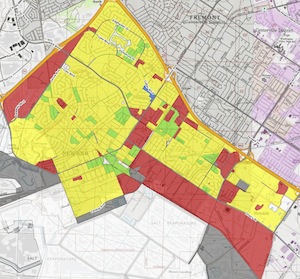
Newark, California rates a solid “C” for residential broadband but drops to a red “D” or grey “f” in the working districts of the city.
There are two worlds of commercial and industrial grade broadband: the specialized business broadband companies and the major incumbent carriers. Analysis of commercial broadband availability in California’s East Bay region shows that many specialized providers want to compete, but can be limited in the scope of their services by basic infrastructure provided by the big guys.
The preliminary findings of the East Bay Broadband Report Card developed by Tellus Venture Associates were presented to the East Bay Broadband Consortium yesterday. On the one hand, ten companies offer business class broadband services in various parts of Alameda, Contra Costa and Solano Counties. Typical service offerings range from 25 to 50 Mbps in the more heavily populated and industrialized area west of the Oakland/Berkeley hills to 10 to 25 Mbps to the east and north.
However, as detailed in a study we conducted for the City of Leandro, the fact that a company advertises a certain service level does not necessarily mean it’s actually available. Competitive carriers do install fiber optic lines in places where commercial demand is demonstrated – usually by a corporate purchase order – but to a great extent they depend on leasing lines from major carriers.
When those lines aren’t available, neither is the advertised level of broadband service. The report card clearly shows that many industrial and commercial districts in the three counties rely on substandard infrastructure that often receives a grade no better than “D”. Sometimes worse.
This variability in core infrastructure points to the need to evaluate business broadband availability on a block by block, and even parcel by parcel basis when pursuing economic development projects. It’s also an opportunity for municipally-backed dark fiber projects, like Lit San Leandro.
